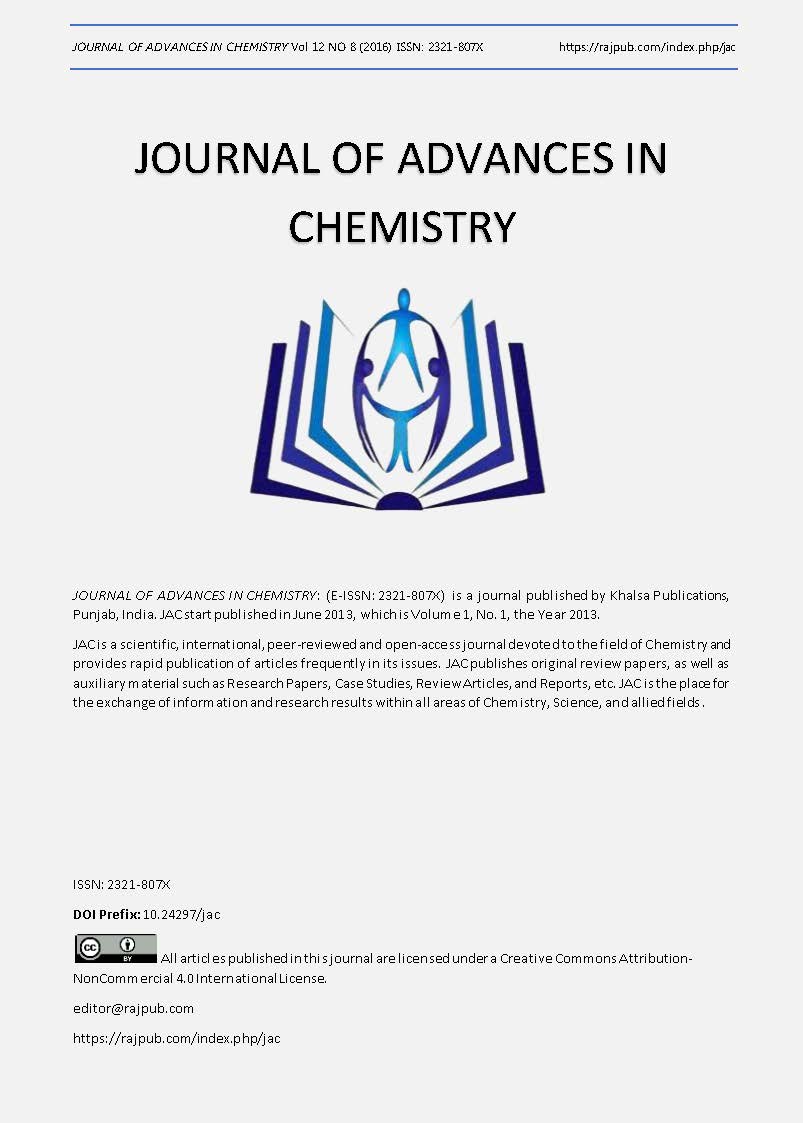Structural and Electrical properties of ZnO Nanorod based dye sensitized solar cell
DOI:
https://doi.org/10.24297/jac.v12i8.6096Keywords:
ZnO, Nanorods, Dye-Sensitized Solar CellAbstract
ThePreparation of nanorod involves simple and novel design of sol-gel process. Further, by using the prepared nanorods,
working electrode will be prepared and it will be sensitized with ruthenium dye. A platinum coated FTO electrode will be
used as a counter electrode. Dye sensitized solar cell will be assembled by using the working electrode and counter
electrode. FE-SEM and UV characteristics have been carried out at 250áµ’C, 350áµ’C&450áµ’C. The size and band gap of
nanorod at these temperatures has been found out to be 1μm and 2.95eV, 200nm and 2.86eV, 100nm and 2.79eV
respectively. The power conversion efficiency and the fill factor have been obtained as 2.72% and 0.722 respectively.
Downloads
References
504,Issue 2, pp. S435-S438.
[2] Giannouli M., Yianoulis P., Syrrokostas G. 2009, Renewable Energy Vol. 34, pp. 1759–1764.
[3] Gratzel M., 2005.Inorg.Chem Vol. 44, pp. 6841-6851
[4] Kim K.S., Kang Y.S., Lee J.H., Shin Y.J., Park N.G., Ryu K.S. & Chang S.H.2006. Bull Korean Chem. Soc,
Vol. 27, pp. 295-298
[5]Lenzmann F.O. & Kroon J.M. 2007. Advances in OptoElectronics Vol.2007, Article ID 65073.
[6] Lewis N.S 2007 Science, Vol 315, pp. 798-801
[7] Michal SOKOLSKÃ, Július CIRÃK, 2010.ActaElectrotechnicaetInformatica, Vol. 10, No. 3, pp. 78–81
[8] Miyasaka T. &Kijitori Y. 2004. J. Electrochem.Soc., Vol. 151(11), pp. A1767-A1773
[9] O‟Regan B. &Gratzel, M. 1991.Nature, Vol. 353, pp. 737–739.
[10] Pagliaro M., Palmisano G., &Ciriminna R. 2008. third print edition of Photovoltaics International journal, w
ww.pv- te ch.org
[11] Raja M., Muthukumarasamy N., Dhayalan.,Velauthapillai, Balasundaraprabhu, R. Agilan., S. &Senthil,
T.S. 2014.Solar Energy Vol 106 pp. 129–135
[12] Thambidurai M., Muthukumarasamy N., Velauthapillai.,Dhayalan., Lee.,Changhee.,2013.J. Mater. Sci:
Mater. Electron. Vol. 24, pp. 2367–2371.
[13] Yen W., Hsieh C., Hung C., Hong-Wen Wang H., &Tsui M. 2010. Journal of the Chinese Chemical
Society, Vol 57, pp.1162-1166.
[14] Wang P., Klein C., Humphry-Baker R., Zakeeruddin S.M. &Gratzel M. 2005. Appl. Phys. Lett. Vol. 86
(12), pp. Art. No.123508
[15] Wijeratne, Kosala, Akilavasan, Jeganathan, Thelakkat, Mukundan, Bandara, Jayasundera, 2012.
Electrochim.Acta, Vol. 72, pp. 192–198.
[16] M. Raja , N. Muthukumarasamy , DhayalanVelauthapillai ,R. Balasundrapraphu , T.S. Senthil , S. Agilan
.2015.Superlattices and Microstructures, Vol80, pp.53–62.
[17] Pawar, R.C., Shaikh, J.S., Shinde, P.S., Pati, P.S., 2011a.Mater.Lett. 65, 2235–2237.
[18] Pawar, R.C., Shaikh, J.S., Babar, A.A., Dhere, P.M., Patil, P.S., 2011b.Sol. Energy 85,,1119–1127.
[19] Qurashi, Ahsanulhaq, Hossain, M.F., Faiz, M., Tabet, N., Alamd, MirWakas, Koteeswara Reddy, N.,
2010. J. Alloys Compd. 503, 40–43.
[20] T.S. Senthil , N. Muthukumarasamy , DhayalanVelauthapillai , S. Agilan , M. Thambidurai ,R.
Balasundaraprabhu, .2011.Renewable Energy, Vol36, pp.2484-2488.
[21] Gratzel M. Dye-sensitized solar cells. J PhotochemPhotobiol C Photochem Rev2003;4:145e53
Downloads
Published
How to Cite
Issue
Section
License
 All articles published in Journal of Advances in Linguistics are licensed under a Creative Commons Attribution 4.0 International License.
All articles published in Journal of Advances in Linguistics are licensed under a Creative Commons Attribution 4.0 International License.




